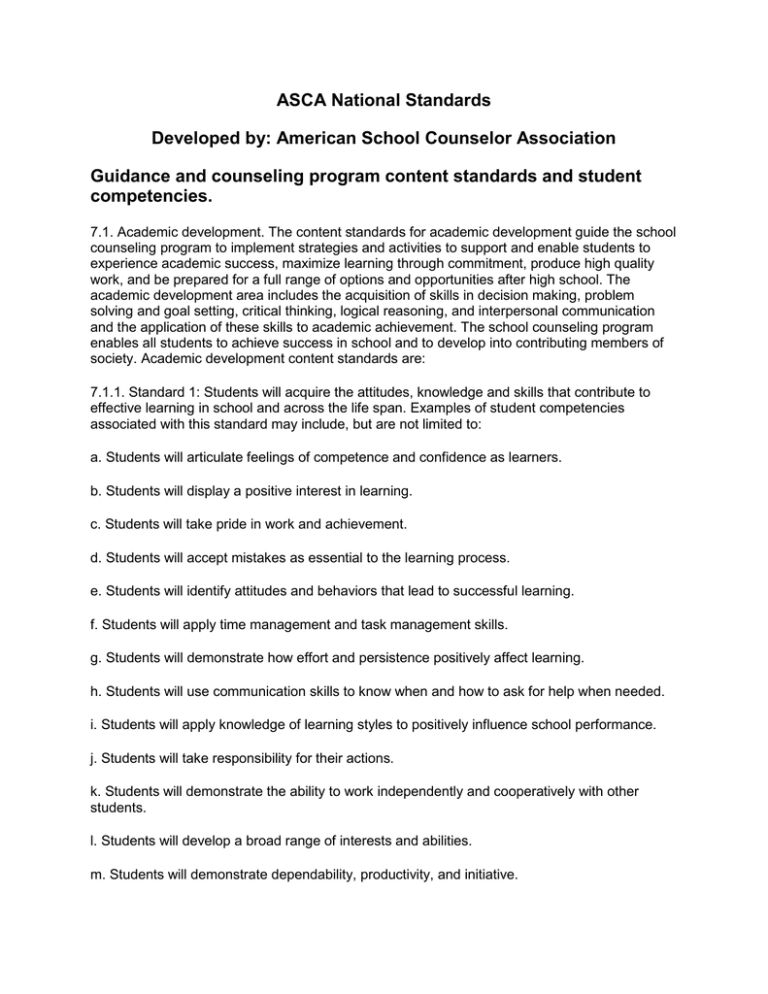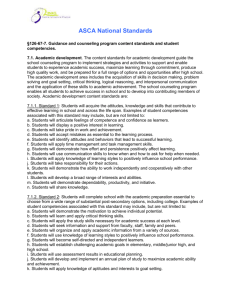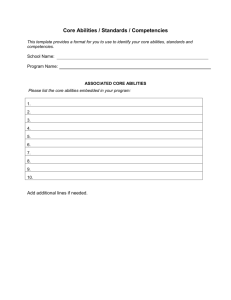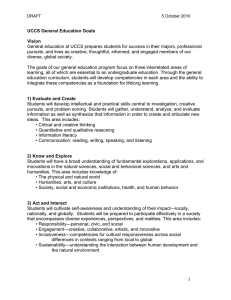ASCA National Standards Developed by: American School Counselor Association
advertisement

ASCA National Standards Developed by: American School Counselor Association Guidance and counseling program content standards and student competencies. 7.1. Academic development. The content standards for academic development guide the school counseling program to implement strategies and activities to support and enable students to experience academic success, maximize learning through commitment, produce high quality work, and be prepared for a full range of options and opportunities after high school. The academic development area includes the acquisition of skills in decision making, problem solving and goal setting, critical thinking, logical reasoning, and interpersonal communication and the application of these skills to academic achievement. The school counseling program enables all students to achieve success in school and to develop into contributing members of society. Academic development content standards are: 7.1.1. Standard 1: Students will acquire the attitudes, knowledge and skills that contribute to effective learning in school and across the life span. Examples of student competencies associated with this standard may include, but are not limited to: a. Students will articulate feelings of competence and confidence as learners. b. Students will display a positive interest in learning. c. Students will take pride in work and achievement. d. Students will accept mistakes as essential to the learning process. e. Students will identify attitudes and behaviors that lead to successful learning. f. Students will apply time management and task management skills. g. Students will demonstrate how effort and persistence positively affect learning. h. Students will use communication skills to know when and how to ask for help when needed. i. Students will apply knowledge of learning styles to positively influence school performance. j. Students will take responsibility for their actions. k. Students will demonstrate the ability to work independently and cooperatively with other students. l. Students will develop a broad range of interests and abilities. m. Students will demonstrate dependability, productivity, and initiative. n. Students will share knowledge. 7.1.2. Standard 2: Students will complete school with the academic preparation essential to choose from a wide range of substantial post-secondary options, including college. Examples of student competencies associated with this standard may include, but are not limited to: a. Students will demonstrate the motivation to achieve individual potential. b. Students will learn and apply critical thinking skills. c. Students will apply the study skills necessary for academic success at each level. d. Students will seek information and support from faculty, staff, family and peers. e. Students will organize and apply academic information from a variety of sources. f. Students will use knowledge of learning styles to positively influence school performance. g. Students will become self-directed and independent learners. h. Students will establish challenging academic goals in elementary, middle/junior high, and high school. i. Students will use assessment results in educational planning. j. Students will develop and implement an annual plan of study to maximize academic ability and achievement. k. Students will apply knowledge of aptitudes and interests to goal setting. l. Students will use problem-solving and decision-making skills to assess progress toward educational goals. m. Students will understand the relationship between classroom performance and success in school. n. Students will identify post-secondary options consistent with interests, achievement, aptitude and abilities. 7.1.3. Standard 3: Students will understand the relationship of academics to the world of work and to life at home and in the community. Examples of student competencies associated with this standard may include, but are not limited to: a. Students will demonstrate the ability to balance school, studies, extracurricular activities, leisure time and family life. b. Student will seek co-curricular and community experiences to enhance the school experience. c. Students will understand the relationship between learning and work. d. Students will demonstrate an understanding of the value of lifelong learning as essential to seeking, obtaining, and maintaining life goals. e. Students will understand that school success is the preparation to make the transition from student to community member. f. Students will understand how school success and academic achievement enhance future career and avocational opportunities. 7.2. Career development. The content standards for career development guide the school counseling program to provide the foundation for the acquisition of skills, attitudes and knowledge enabling students to make a successful transition from school to the world of work and from job to job across the life career span. The career development content standards are: 7.2.1. Standard 4: Students will acquire the skills to investigate the world of work in relation to knowledge of self and to make informed career decisions. Examples of student competencies associated with this standard may include, but are not limited to: a. Students will develop skills to locate, evaluate, and interpret career information. b. Students will learn about the variety of traditional and nontraditional occupations. c. Students will develop an awareness of personal abilities, skills, interests, and motivations. d. Students will learn how to interact and work cooperatively in teams. e. Students will learn to make decisions. f. Students will learn how to set goals. g. Students will understand the importance of planning. h. Students will pursue and develop competency in areas of interest. i. Students will develop avocational interests. j. Students will learn to balance work and leisure time. k. Students will acquire employability skills such as working on a team, problem solving, and organizational skills. l. Students will apply job readiness skills to seek employment opportunities. m. Students will demonstrate knowledge about the changing workplace. n. Students will learn about the rights and responsibilities of employers and employees. o. Students will learn to respect individual uniqueness in the workplace. p. Students will learn how to write a resume. q. Students will develop a positive attitude toward work and learning. r. Students will understand the importance of responsibility, dependability, punctuality, integrity, and effort in the workplace. s. Students will utilize time and task management skills. 7.2.2. Standard 5: Students will employ strategies to achieve future career success and satisfaction. Examples of student competencies associated with this standard may include, but are not limited to: a. Students will apply decision-making skills to career planning, course selection, and career transitions. b. Students will identify personal skills, interests, and abilities and relate them to current career choices. c. Students will demonstrate knowledge of the career planning process. d. Students will know the various ways which occupations can be classified. e. Students will use research and information resources to obtain career information. f. Students will learn to use the Internet to access career planning information. g. Students will describe traditional and nontraditional occupations and how these relate to career choice. h. Students will understand how changing economic and societal needs influence employment trends and future training. i. Students will demonstrate awareness of the education and training needed to achieve career goals. j. Students will assess and modify their educational plans to support career goals. k. Students will use employability and job readiness skills in internship, mentoring, shadowing, and/or other world of work experiences. l. Students will select coursework that is related to career interests. m. Students will maintain a career planning portfolio. 7.2.3. Standard 6: Students will understand the relationship between personal qualities, education and training, and the world of work. Examples of student competencies associated with this standard may include, but are not limited to: a. Students will understand the relationship between educational achievement and career success. b. Students will explain how work can help to achieve personal success and satisfaction. c. Students will identify personal preferences and interests that influence career choices and success. d. Students will understand that the changing workplace requires lifelong learning and acquiring new skills. e. Students will describe the effect of work on lifestyles. f. Students will understand the importance of equity and access in career choice. g. Students will understand that work is an important and satisfying means of personal expression. h. Students will demonstrate how interests, abilities, and achievement relate to achieving personal, social, educational, and career goals. i. Students will learn how to use conflict management skills with peers and adults. j. Students will learn to work cooperatively with others as a team member. k. Students will apply academic and employment readiness skills in work-based learning situations such as internships, shadowing, and mentoring experiences. 7.3. Personal/social development. The content standards for personal/social development guide the school counseling program to provide the foundation for personal and social growth as students progress through school and into adulthood. The personal/social development content standards are: 7.3.1. Standard 7: Students will acquire the attitudes, knowledge and interpersonal skills to help them understand and respect self and others. Examples of student competencies associated with this standard may include, but are not limited to: a. Students will develop a positive attitude toward self as a unique and worthy person. b. Students will identify personal values, attitudes and beliefs. c. Students will learn the goal setting process. d. Students will understand change as a part of growth. e. Students will identify and express feelings. f. Students will distinguish between appropriate and inappropriate behaviors. g. Students will recognize personal boundaries, rights, and privacy needs. h. Students will understand the need for self-control and how to practice it. i. Students will demonstrate cooperative behavior in groups. j. Students will identify personal strengths and assets. k. Students will identify and discuss changing personal and social roles. l. Students will identify and recognize changing family roles. m. Students will recognize the rights and responsibilities of all persons. n. Students will respect alternative points of view. o. Students will recognize and respect individual ethnic and cultural differences. p. Students will use effective communication skills. q. Students will recognize that communication involves speaking, listening, and non-verbal behavior. r. Students will learn how to communicate effectively. s. Students will learn how to make and keep friends. 7.3.2. Standard 8: Students will make decisions, set goals, and take necessary action to achieve goals. Examples of student competencies associated with this standard may include, but are not limited to: a. Students will use a decision-making and a problem-solving model. b. Students will understand consequences of decisions and choices. c. Students will identify alternative solutions to a problem. d. Students will develop effective coping skills for dealing with problems. e. Students will demonstrate when, where, and how to seek help for solving problems and making decisions. f. Students will know how to apply conflict resolution skills. g. Students will know when peer pressure is influencing a decision. h. Students will identify long- and short-term goals. i. Students will identify alternative ways of achieving goals. j. Students will use persistence and perseverance in acquiring knowledge and skills. k. Students will develop an action plan to set and achieve realistic goals. 7.3.3. Standard 9: Students will understand safety and survival skills. Examples of student competencies associated with this standard may include, but are not limited to: a. Students will demonstrate knowledge of personal information (e.g., telephone number, home address, emergency contact). b. Students will learn about the relationship between rules, laws, safety, and the protection of an individual's rights. c. Students will learn the difference between appropriate and inappropriate physical contact. d. Students will demonstrate the ability to assert boundaries, rights and personal privacy. e. Students will differentiate between situations requiring peer support and situations requiring adult professional help. f. Students will identify resource people in the school and community and know how to seek their help. g. Students will apply effective problem-solving and decision-making skills to make safe and healthy choices. h. Students will learn about the emotional and physical dangers of substance use and abuse. i. Students will lean how to cope with peer pressure. j. Students will learn techniques for managing stress and conflict. k. Students will learn coping skills for managing life events.




